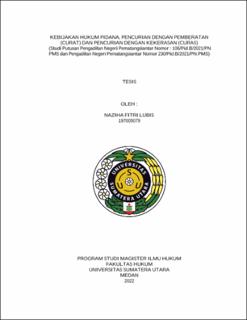| dc.description.abstract | Criminal policy is a comprehensive policy, implemented through laws, regulations, and government agencies, aimed at upholding the core norms of society, and includes law enforcement in the area of public control,
regulation, or reconciliation. It is a comprehensive government policy. This includes the discipline of making and enforcing laws and regulations to achieve social welfare or prosperity. Crime prevention strategies are based on penal and non- penal approaches. The theoretical framework used as an analytical knife in this case is the theory of criminal policy. Prevention of legal action. Functionalization or implementation is a type of crime with several stages, namely the formulation stage, the implementation stage, the implementation and control stage, the Pematangsiantar Police. This is done through actions such as arrest, confiscation, detention, examination of witnesses, examination of suspects, and sentencing. The non-penal policy adopted by the Pematangsiantar Police is to carry out community outreach and patrols, kring detectives, applications for handling quick actions, namely the 110 system, namely telephones that directly receive services, the Polisku application. Basic considerations of judges in enforcing the law of criminal acts of curing, curas and theft in the decision of the Pematangsiantar District Court Number: 106/PID.B/2021/PN PMS and the decision of the Pematangsiantar District Court Number 230/Pid.B/2021/PN. PMS). Article 363 paragraph (1) 3rd, 4, 5 of the Criminal Code, the elements of which are as follows: 1. Whoever, 2. Takes something that completely or partially belongs to another person with the intention of illegally possessing it. 3. What is done at night in a closed house or yard where there is a house, done by a person who is there without his knowledge or contrary to the will of the rightful person; 4. Performed by two or more people. | en_US |


